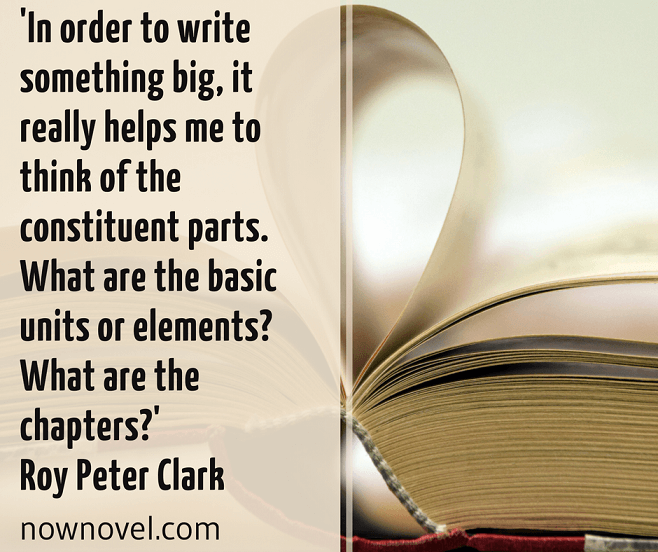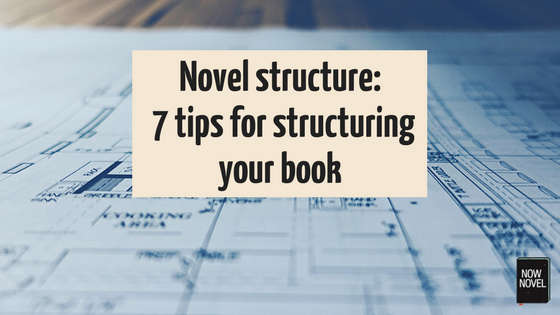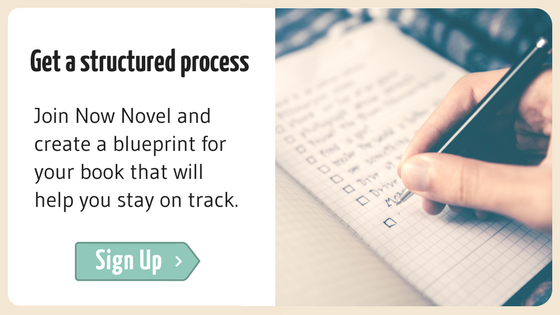Understanding how to structure a novel makes your story easier and more satisfying to read. Good structure creates plot clarity and cohesion. Read 7 tips for how to structure your book, including story structure examples from accomplished novels:
1: Understand basic story structure
2: Learn the pros of different story structure types
3: Know how to structure a novel to suit your central idea
4: Modify story structure templates to suit your plot
5: Create novel structure early to simplify your process
6: Make your story structure largely invisible
7: Know and play with structure typical of your genre
Let’s examine each of these points in more detail:
1: Understand basic story structure
Basic story structure, at its most elementary level, means giving your novel a clearly defined begining, middle and end.
The beginning typically will:
- Show the inciting incident that sets the story in motion (for example, in J.K. Rowling’s Harry Potter series, the inciting incident is the arrival of mysterious letters addressed to Harry from Hogwarts School of Witchcraft and Wizardry)
- Introduce the primary characters of the story
- Establish the setting of the story
- Give readers an idea of where the story is headed (the opening line of Tolstoy’s Anna Karenina (1877), for example, tells us it will feature unhappy family situations: ‘Happy families are all alike; every unhappy family is unhappy in its own way.’)
The middle of a novel is where there is substantial change. Secondary characters come or go and other aspects such as setting may change. Obstacles to central characters’ goals emerge.
By the middle, the central idea of your story should be clear. Take John le Carré’s espionage novel The Night Manager (1993), for example. We know by the middle that the protagonist Jonathan Pine’s goal is to defeat the crooked billionaire smuggler, Richard Roper. By the middle of the book, we see the extent of Pine’s entanglement. He manages to infiltrate Roper’s inner circle. The middle is where plot complications – like Pine’s dangerous double agent dealings – stack up.
A great ending ties the story’s strands together. Even if there is no final resolution (like in series where central conflicts span multiple novels), each book resolves, at least, a major secondary conflict. There is the structural sense of things drawing to a close. These same rules apply on a smaller level to individual scenes (our free guide to scene structure will help you make small scale structure strong, too).
Creating good story structure means balancing your story’s introduction, development, and conclusion. If your story is all introduction and no development, it can feel static and stale. Allow your characters’ goals to grow and change.
2: Learn the pros of different story structure types
There are many different story structure types. Popular types include:
- Three act structure: the story can be divided into three parts. Classic novels of voyage and return, for example, often follow this structure. Randy Ingermanson breaks down this structure in fantasy series such as Harry Potter and Twilight
- Orson Scott Card’s 4 story structures: In a post for Writer’s Digest, Orson Scott Card details four story structure types according to the plot details authors structure stories around. They are:
a) The Milieu Story: An observer who sees things the way we see them experiences a strange place (e.g. Dorothy in The Wizard of Oz) – the story is structured around the experience of a strange and outlandish setting.
b) The Idea Story: A question is raised and answered (e.g. in mystery novels, the central questions ‘who’ and ‘why’? Who was the killer and what was their motive?
c) The Character Story: A character goes through immense inner change, and this is the story’s main focus. Coming-of-age novels, such as James Joyce’s A Portrait of the Artist as a Young Man (1916) typify this structure.
d) The Event Story: Something is wrong with the world and either a new order must be established or the old must be destroyed. The Lord of the Rings, in which the tyrant Sauron must be stopped, is a classic example. - Mirror structure: In David Mitchell’s Cloud Atlas (2004), each section of the book is left incomplete until the book’s central section. From there, Mitchell resolves the unfinished character arcs in reverse order, ending with the first character’s arc and setting
The above examples show that structure can refer to how we decide to divide up the parts of the story. As with Orson Scott Card’s four story structure types, it also refers to how we build and arrange a story around a central idea. Each structure type has pros and cons. One might be too linear for the type of story you want to tell, for example, that might suit a more fragmented, non-linear approach. This leads to the next point:
3: Know how to structure a novel to suit your central idea
When you decide how to structure a novel, think about your central idea. What would best suit your story type?
A story, for example, about an adventure and return home (like The Lord of the Rings or Homer’s Odyssey) might suit Three Act Structure because of the simple three-part narrative arc: ‘home – away – home again’.
Think about the mirror structure of David Mitchell’s Cloud Atlas described above. The novel begins with diary excerpts by a sailor living in 1850. The middle section follows a different character. It could be set in pre-modern times, following tribal life, but we slowly realize it might describe a post-apocalyptic future, a return to tribal life wrought by conflict or disaster.
In Cloud Atlas, the idea of history being cyclical – of returning to the beginning and starting over – is everywhere. We see it in both the changing time-frame of the story and how its individual chapters circle back to previous, unfinished story arcs. The mirror structure of the book is thus perfect for showing cyclical, repetitive elements of history – how society builds itself up and tears itself back down to start all over.
It’s the perfect novel structure for a story that explores cycles of power struggle and violence, how individuals and groups prey on others. It’s an imaginative study of society and its capacity for self-inflicted ruin.
Think how you can structure your story so that the structure itself – the ordering of scenes, time-frames and events – creates meaning. It would make sense, for example, for a novel where the protagonist has amnesia, to include structural holes and gaps. You might have ‘missing’ chapters the story later fills in. Allow yourself to play with structure as you would with setting and characterization. Have fun with it.

4: Modify story structure templates to suit your plot
If you are still learning how to structure a novel, creating your own, flexible blueprint is a good idea. (You can use the Now Novel Idea Finder to help with this). Sometimes, using a pre-existing template will force you to twist and contort your story to fit a structure and this doesn’t always work.
If you do use a story structure template (such as this template here), give yourself the freedom to modify the template as you see fit. Perhaps, for example, you want to show the climax of the story first, then circle back to the exposition. This approach – beginning with your story’s most dramatic and perplexing point – is popular in genres such as murder mysteries. The mystery of the killer’s identity or motivation is intriguing enough for readers not to mind that you began with the climax before introducing characters and giving backstory and rising action.
5: Create novel structure early to simplify your process
Although you can go back and restructure your story once you’ve finished drafting, it’s a good idea to work out the skeleton of your story first and move from there.
Of course not everyone is a plotter by nature. However, writer’s block is a risk if you don’t at least have some idea of how you will reach the end. Think of early story structure like an architect’s blueprint: The architect doesn’t design a house brick by brick – there are rooms, features (like plot events) and functions (characters’ purposes and goals) they know the design should ideally include.
The key point is that the structure you create before you draft should be flexible. Ultimately, allow your characters to take the story to whatever destination they want. Structuring from the start will simply make it easier to construct their paths.
6: Make your story structure largely invisible
Knowing how to structure a novel and how to structure a narrative essay are two different skills. In a narrative essay, you might have extremely visible structure. You might have a table of contents, numbered section headings, numbered footnotes. In fiction, you could purposefully draw attention to your novel’s structure. This can even be clever (a novel about a school play that goes horribly, comically wrong, for example, might have sections titled ‘Act I’, ‘Act II’ and ‘Act III’, for example, and a list of ‘dramatis personae’).
Yet when it comes to creating a sense of progression from beginning to middle to end, avoid Victorian approaches such as writing ‘And now, reader, we approach the end of our story’. The events themselves should give us a clue the story is winding to a close: The heroes reach the villain’s hideout and the final confrontation, for example. Good story structure needs no accompanying explanation.
7: Know and play with structure typical of your genre
Knowing how to structure a novel so it follows (or breaks) conventions of your genre is a useful skill. In fantasy quests, for example, there is often a three-part ‘voyage and return’ structure (as in the three separate books of The Lord of the Rings). Other common genre-specific structures include:
- Romance: The romantic leads dislike or tease each other at first but by the middle or final third of the story, their attraction is certain. Countless novels as well as TV series such as New Girl and The Mindy Project use this plot structure
- Suspense: Typically the investigation of the crime has a spiral-like structure, where the detective’s fact-finding circles them increasingly closer to the perpetrator
- Drama: In novels about personal tragedy, three act structure often features. We see a rise, a fall and the aftermath
When you read novels in your genre, examine their structure. As an exercise, note:
- What ground the introduction or beginning of the story covers – who do we meet and what do we know about them by the end of the first chapter?
- By the middle of the book, how have things changed?
- How does the story end, and how does it compare to other books in the genre?
Want to create a helpful blueprint for your novel, one that gathers all your ideas for settings, characters, themes and plot events together? Join Now Novel and use the Idea Finder to brainstorm your best ideas.



6 replies on “Novel structure: 7 tips for structuring your book”
When thinking of novel structure, I always come back to the perennially and generationally popular, The Catcher in the Rye, by JD Salinger. A wild ride, from being kicked out of Pency Prep, to watching Phoebe at the carousel–and none of it with any true structure except that which the literati ascribe to it.
One could even go so far as to say that Catcher defies conventional wisdom for structure. A journey to Phoebe? We don’t know that until the final pages. A ticking time clock to push the action? Not one tick. Subplots? Not really, no.
From nuns, to a pimp, from eternally-showering Ackerly, to phony and handsome Stradlater, the book is ripe with vignettes that reek of symbolism. And the voice of Holden is second to none other. But plot? As thin as the pages of the family Bible.
Thanks for sharing your perspective, Sven. A good point – there are endless ways to write a fascinating read and not all of them need Big Ideas or complex plot developments. Franny and Zooey is another Salinger classic that relies on interesting characterization more than plot.
Thank you all so very much for all these tips, this is very helpful to me,:)
Hi Victoria – I’m thrilled to hear that. Best of luck with your writing!
Thank you! I found this helped me a lot!
[…] composition in the form of a book is trying to create an outline for the story. This will help you give a proper structure to your novel and increase its readability as […]